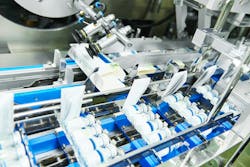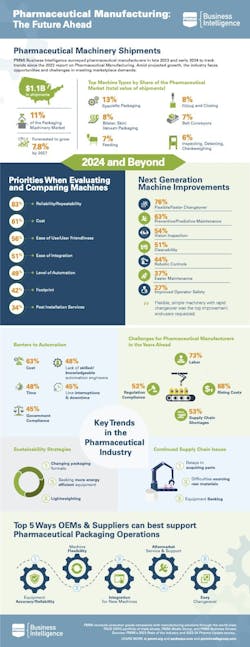An infographic (posted below) released by PMMI, The Association for Packaging and Processing Technologies, notes that the forecasted expansion of the pharmaceutical machinery market is driven by enhancements in technology, automation, sustainability and supply chain challenges.
According to PMMI, in 2022, shipments of pharmaceutical machinery amounted to $1.1 billion, representing 11% of the packaging machinery market, with a forecasted compound annual growth rate (CAGR) of 7.8% by 2027. This growth trajectory surpasses that of several larger sectors, including the food industry, which is projected to have a CAGR of 7.3%.
“The pharmaceutical sector has recently announced high levels of production expansion investments. A large portion of the biggest pharmaceutical manufacturers have announced capacity expansion in the billions, with the majority of investment going toward expanding capacity in North Carolina,” says Rebecca Marquez, director, custom research, PMMI. “This has pushed forecasted growth of packaging machine shipments to the pharmaceutical sector up for 2023 and 2024 compared to other industries.”
Marquez cites e-commerce and central pharmacies as reasons for this growth. As e-commerce continues to proliferate, there is a trend toward multi-client order fulfillment centers. This landscape will represent a significant growth opportunity for packaging machine builders. Also driving growth in pharmaceutical machinery is the rise of central pharmacies, providing the ability for third parties to fill prescriptions within the U.S. Central pharmacies that sit between the retail pharmacy and wholesaler and serve multiple pharmacies. Increasingly, central pharmacies are being used to serve mail-order prescriptions in the growing e-commerce landscape.
With regard to plans in 2024, PMMI said manufacturers have identified reliability/repeatability (83%) as a top priority when evaluating and comparing machines and flexibility/faster changeover (76%) as a critical improvement for next-generation machines. The infographic also details the key trends affecting the pharmaceutical industry. Automating costs, labor, changing packaging formats due to sustainability requirements, and delays in acquiring parts were all identified as challenges for the industry in their respective categories. Finally, the latest data shows the top five ways OEMs and suppliers can best support pharmaceutical packaging operations, with equipment accuracy and reliability leading the way.


